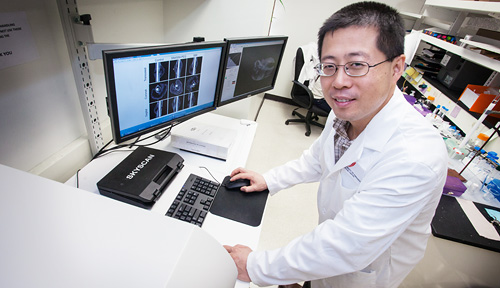To Dong Wang, Ph.D., drug delivery is like adding salt to your food. You’ve got to get it right.
Now, with nanomedicine, we have the ability to target precise areas with precise doses. And during his postdoc training, Dr. Wang got the idea that nanomedicine might be used to target inflammation too.
Since UNMC is recognized for its work in nanomedicine, Dr. Wang, associate professor of pharmaceutical sciences in the College of Pharmacy, was onto something. And collaboration with orthopaedics gave him another idea.
Orthopaedic surgeons often see patients who suffer from difficulty brought on by tiny particles from the wear and tear of artificial joints.
“An inflammatory response to those particles leads to bone destruction, and that can cause big problems,” said Ed Fehringer, M.D., an adjunct associate professor at UNMC. Dr. Wang first collaborated with Dr. Fehringer, a former associate professor of orthopaedics at UNMC who went into private practice in 2012. The two have since broadened their interdisciplinary collaboration to include materials expert Hani Haider, Ph.D., professor, and surgeon Curtis Hartman, M.D., assistant professor in the department of orthopaedic surgery and rehabilitation. The department chairman, Kevin Garvin, M.D., also has been extremely supportive with clinical guidance and acquisition of major equipment, Dr. Wang said.
Enter yet another collaborator — Steven Goldring, M.D., chief scientific officer at the Hospital for Special Surgery in New York, the nation’s No. 1 orthopedics hospital according to U.S. News and World Report. Dr. Wang’s friend and mentor, he liked where they were going and offered the use of his mouse model.
Dr. Wang’s team injected the mice with particles and measured how inflammation attacked the bone. Later, they created another mouse model in which they inserted tiny titanium pins to simulate the effects of artificial joints in humans. Using an imaging probe based on their nanomedicine platform, the team searched for signs of inflammation before bone breakdown.
Imaging is possible because local blood vessels become leaky in response to inflammation. Normally that’s absorbed by the body and we’d never know it. But, by using the nanomedicine platform to target minute doses of radiation to the area, those leaks — the first signs of inflammation — show up on imaging scans.
In home-repair parlance, it’s like using soapy water to find an air leak in a tire. The resulting bubbles pinpoint escaping air, even from a hole too small to see.
“We want to see the implant failure coming,” Dr. Wang said. “We don’t want to wait until patients start to feel the pain in their hip or can hear a sound in their knee.”
The goal is to implement an early warning system. Caught early, inflammation in patients with artificial joints can be treated before it becomes a real problem.
And the team did see it. Using technology patented by Drs. Wang, Fehringer and Goldring, the investigators could see a difference in the leg with the particles before any bone erosion even appeared on a CT scan. “In other words,” Dr. Wang said, “we saw the initiating pathology before the real bone damage happens. That’s a big thing.”
The next step would be to preemptively treat the inflammation. Targeted anti-inflammatory nanomedicine would put the right dose in the right place, while minimizing the risk of side effects. And in the mouse models, that worked too: a study by one of Dr.Wang’s students showed the bone next to the implant was preserved.
The hope is to someday take that diagnosis and treatment technology and apply it to people — the kind of patients UNMC ortho clinicians see in their practice.
It would be better to have screening tests once a year, Dr. Wang said, than to wait six years or so, only to undergo another surgery, take out an old artificial joint, put in a new one, and start recovery all over again.
